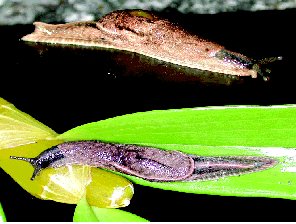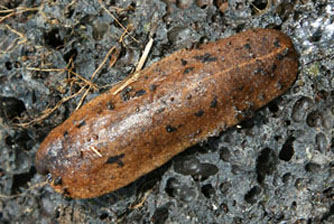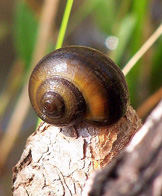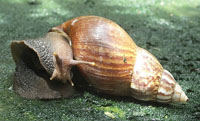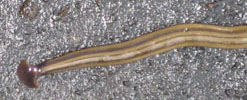Angiostrongylus cantonensis, or rat lungworm, is a parasitic nematode (roundworm) that spends it natural life cycle in the bodies of rats and mollusks. It has been on the islands since the first half of the 1900’s but only within the past few years has it proven to be a serious problem to humans by causing eosinophilic meningitis or meningoencephalitis. Previous to 2004, the only report of humans becoming ill from A. cantonensis in Hawai‘i was when they chose to eat under cooked or uncooked mollusks. The mode of transmission to humans changed with the introduction of a very invasive semislug called Parmarion martensi in 2004. Humans who had not intentionally eaten under cooked or raw mollusks were becoming ill.
Parmarion martensi not only crawls across the land, it climbs on the sides of houses, raised lanai, catchment tanks, and trees. People have been accidently consuming semislugs, either hidden in leaf folds or chopped or blended with the produce. According to studies done by Robert Hollingsworth, plant pest researcher with the USDA here on the island, and others, 77.5 percent of the semislugs in Puna were infected with large numbers of the parasite, compared to 24.3 percent of other snails and slugs. The semislug leaves a heavy slime trail that the parasite has been found in. It is thought that the parasite can only live for a short time in the slime trail, particularly if it is dried out.
These are just a few of the more common organisms that can transmit the ratlung worm illness.
If ingested, A. cantonensis, the rat lungworm, can cause eosinophilic meningitis or meningoencephalitis. The symptoms can be mild or severe. Mild cases may only be a headache, nausea, and a painful stiff neck, arm and shoulder accompanied by muscle rigidity. Moderately serious cases can effect the whole body and the patient can be in severe pain, including what people describe as "painful skin", as well as paralyses, parasthesia (pins and needles) and hyperesthesia (abnormal sensitivity to stimuli of the senses). Eyesight and hearing can also be effected. Visual impairment, retinal edema and ocular pain can occur. Serious cases can cause coma when nematodes enter the brain, and leave tracks that cause brain damage and swelling. Recently, three people were hospitalized and in comas. Even in the milder forms of this illness, symptoms may take years to resolve, or may never completely resolve.
If you have reason to believe that you may have swallowed a slug, or eaten contaminated uncooked greens, make yourself vomit and seek medical treatment. The best treatment seems to be prednisone to prevent inflammation and an anti-helminth such as Ivermectin. Unlike some other anti-helminths, Ivermectin paralizes the roundworm instead of outright killing it (some doctors and scientists think that paralizing the worms instead of killing them may result in less inflammation). There is an antibody test available to test for infection, but it may not detect antibodies until weeks after the onset of symptoms. Considered with symptoms, a blood test for eosinophils is indicative of parasitic meningitis as opposed to other forms of meningitis. Testing the spinal fluid for nematodes is another way of confirming the disease.
Life cycle
The definitive host is the rat where adult worms reside in the pulmonary arteries. Eggs are then released and carried in the blood stream to the lungs, the eggs break through the pulmonary tract and are swallowed. 1st stage larvae hatch in the intestine and are 17 – 25 mm (a little over 1/2 inch) long, up to 26 microns in diameter and are passed in the stool of the rat which mollusks feed on. These are the intermediate hosts, snails, semislugs and slugs. The larvae develop to 3rd stage larvae within the intermediate host. The cycle is completed when the rats eat the intermediate hosts. Humans and other mammals can be infected by the ingestion of the infective 3rd state larvae present in the intermediate hosts or on vegetation. 3rd stage larvae are also present in accidental hosts such as flatworms (planarian or hammerhead worms) that parasitize the slugs and snails. In this stage, the larvae are so small that they can barely be seen.
Humans and other mammals come into the picture when they ingest the mollusk or other carrier.
Preventative measures
Any slug, snail, fresh water mollusk or accidental host can be infected. Thoroughly inspect and wash all produce in several baths. Distilled water is said to be most effective in killing the nematode, though by some reports, not consistently. It is unknown, at this point, whether vinegar or grapefruit seed extract is effective. It is a good idea to let the produce to sit inside for a while after washing, and only pick vegetables in the heat and light of the day as the slugs tend to hide in moist or shady places in the day. Effective measures for growing produce that you will not be cooking, such as greens, is to build a slug proof greenhouse, or to make tables and paint the legs with copper napthanate or copper sulfate solution, or by devising other ways to keep them off of a table. Households on catchment water should use at least a 10 micron filter or boil the water for at least 3 minutes. According to Cheng and Alicata, 1964, 3rd stage A. cantonensis larvae may live up to 72 hours in water.
Last, but certainly not least. Get rid of rats from around your home and garden areas.
If anyone has comments or suggestions please email the webmaster and we will post your comments or questions.
We are collecting testimonies of people who have had rat lungworm to present to appropriate agencies and convince them of the urgent need for research on safe food preparation and medical treatment. If you have had rat lungworm, or know of anyone who has had it, please contact us at our website and fill out our Survey.
